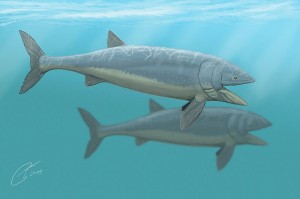It is an interesting paradox of the natural world that some of the largest species alive survive by eating some of the smallest species.
Consider the largest animal ever known to have existed. No, it is not a dinosaur, but an animal alive today, the blue whale, Balaenoptera musculus. This behemoth can grow to over 100 feet long and weigh 380,000 pounds. And yet, this animal does not eat large fish, but tiny planktonic animals, those that float in the water.
The blue whale belongs to the suborder of baleen whales, or mysticets, that all make their living by filter feeding plankton—sucking water into their mouths and trapping the small, floating plankton to swallow. The toothed whales, or odontocets, do eat larger prey.
There are several other large vertebrate groups that also specialize in eating the very small, and they too grow to very large proportions. For example, the whale shark (Rhincodon typus), the largest living fish at about 40 feet long and weighing in at 47,000 pounds. And then there is the second largest fish, the basking shark (Cetorhinus maximus), also a filter feeder. Giant rays also feed this way.
So clearly, you can get very big eating small things. However, there has been a bit of a mystery in the fossil record. There has been a general lack of known filter feeding animals from the fossil record during the Mesozoic, the time of dinosaurs; clearly, that was a period in Earth’s history when things could get very large. So, where were the filter feeders?
An important piece of this puzzle has just fallen into place. Just published in Science is a paper outlining new discoveries of filter feeding fishes from the Mesozoic, and it turns out that they too were large (Friedman et al., 2010).
The fossils were mostly already in the collections of museums, having been collected in both Europe and North America. However, they were not well understood until this team began to look at them in more detail, and recognized their filter feeding adaptations. The fossils reported belong to the extinct pachycormid family, and include the new genus Bonnerichthys, named for the Bonner family of Kansas.
And in keeping with a theme, the pachycormid family of fish included the largest bony fish known, Leedsichthys, reaching over 30 feet in length in the Jurassic of Europe.
This latest work shows that in fact there were a number of filter feeding fish through about the last 100 million years of the Mesozoic, filling this lucrative niche held in modern times by rays, sharks, and whales. Another mystery from the past is closer to being solved.
FRIEDMAN, M., K. SHIMADA, L. MARTIN, M. J. EVERHART, J. LISTON, A. MALTESE, AND M. TRIEBOLD. 2010. 100-million-year dynasty of giant planktivorous bony fishes in the Mesozoic seas. Science, 327:990-993.
Many other interesting facts can be found here at Boneblogger. Look around and enjoy.

